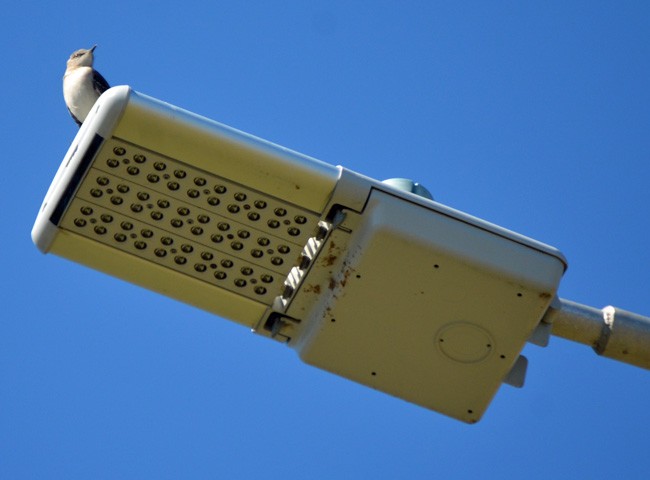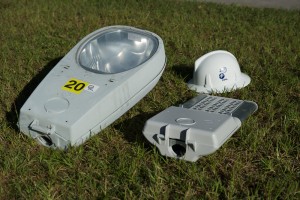
LED lighting—or light emitting diodes—is in your hands and all around you: it’s the backlighting to your smart phone, it lights up your television and your computer screen, and it’s increasingly lighting the way ahead as you drive at night, with white LEDs replacing yellowish headlights. At the western end of Palm Coast Parkway, it also lights up the street from above, as Florida Power and Light installed a run of LED lights a couple of years ago as one of a handful of such pilot projects in Florida cities.
Slowly, LED lighting is entering homes, too. Residential LEDS, the U.S. Department of Energy says, use at least 75 percent less energy than incandescent lights, and last 25 times longer. They release (or waste) almost no heat. They have none of the poisonous mercury in fluorescent lights. Within a dozen years, the widespread use of LEDs, the Department of Energy predicts, could save the equivalent annual electric output of 44 power plants and $30 billion (at today’s prices).
Ask Palm Coast City Council member Steven Nobile. “I can guarantee you one thing,” he said on Tuesday during a council discussion about LEDS, referring to his household’s “bazillion Christmas lights. My electric bill around December was about $500, OK? This year, we went all LED. $200. And they were actually new lights, so there’s got to be a saving. Going LED, you know, there’s got to be a saving.” Referring to the length of time for a viable return on investment, he said: “If it’s 10 years, I’m still OK with it, because it’s more than the dollar savings that we’re benefiting here.”
The council was discussing LEDs because the city administration is looking for direction on what to do with the city’s 3,000-odd street lights, and the many more street lights that will be installed from here on. City Manager Jim Landon presented options as to “whether or not it’s time to start implementing an LED program or wait.”
The city could retrofit the entire network with LED lights, but that would be prohibitively expensive right now, particularly as LED prices are expected to plummet in coming years: “The current rate of cost decline in LED lighting systems is about 20 percent a year,” the Department of Energy says.
On Tuesday, the council agreed to this approach: The city will replace lights that break down, or utility poles that get damaged, with LED lights, and go LED-only wherever it adds new lights, as along Palm Coast Parkway, where the road is being widened, and along Old Kings Road, when it is widened. Whenever it adds alight at a residential intersection, or responds to a request for a light in residential areas, it will make LED lighting the priority.
But the city will not yet retrofit its 3,000 existing lights. Rather, in a year or 18 months, it will return to the council with a report on LED lighting in the city, with more solid numbers on energy consumption and the outlook for more such additions in the future. Then, it may do what council member Jason DeLorenzo proposed: create a10-year program and replace all city lights with LED lighting over that span. For the city, the long-term savings could be significant.

It’s not as simple as asking FPL to replace all lighting with LED lights. Currently, FPL owns the utility poles and the lights it installs. It bills the city for the usage, with the capital and maintenance cost folded into the total price, which includes electricity usage. Surprisingly for most, energy usage is actually a lower cost than maintenance.
If Palm Coast wants to convert its existing lights—which are called High Pressure Sodium Vapor lights, or HPSV) top LEDs, the cost for a 100-watt light would be $500 (that’s the most common), and for a 200-watt bulb, it would be $600. That includes FPL’s costs for sending out a truck, installing the hardware, and maintaining it subsequently, with replacements when necessary. The rough cost of converting all the city’s lights would, at $500 a light, come out to $1.5 million, not including the subsequent energy costs.
But the estimated monthly saving on each 500-watt bulb would be $6, it would be $8 for 200-watt bulbs, and $11 for 400-watt bulbs. The city would save at least $18,000 a month in energy costs if all its lights were the 100-watt kind (they’re not, so the savings would be higher). In other words, the city would make back its investment in seven years on every 100-watt installation, at today’s prices. If the Department of Energy’s prediction holds true that LED costs will continue to fall 20 percent a year for the foreseeable future, the savings would grow proportionately.
But the matter is still too much in flux for the city to commit too radically. “This is not cutting edge, but it’s definitely not a stable situation, it’s moving,” Landon said.
The discussion Tuesday was prompted by FPL’s installation of that string of LEDs at the end of Palm Coast Parkway. Palm Coast got the pilot program because the city, always interested in green initiatives, had consistently pushed for LED lighting.
Now FPL is wanting to take down the LED lights at that end. It’s giving Palm Coast a choice: replace them with the old kind of high-pressure sodium lights, at no cost to the city, or, to stick with LED fixtures, the cost would be approximately $15,000.
That got Palm Coast Mayor angry.
“What’s wrong with leaving the existing LED fixtures up until they burn out?” the mayor asked.
“Thank you, that’s what we said,” Landon said.

“This sounds to me like an issue for the Public Utilities Commission, the PUC,” Netts said, referring to the state Public Service Commission, or PSC. “This is extortion, as far as I’m concerned. This is ridiculous.” Getting angrier, Netts said he would call the PSC himself, though he was dissuaded from doing so later, to give the city a chance to talk to FPL.
Looking at the broader lighting landscape, just one council member questioned the LED approach: “This entire presentation,” he said, “it’s all based upon estimated costs and estimated savings. I want to see some hard numbers. Let me see some hard numbers as to what the difference is to erect and maintain a sodium as opposed to an LED, then maybe I’ll get behind this.”
“What I would suggest to address your issue is, the next time we order a street light, let’s do LED. They will then put together our rate sheet, our contract, and in that, they’re going to tell us how much that new light is going to cost us per month, and how much installation costs would be. If they are substantially different and we don’t see a six-year return on investment, then we’ll come back and discuss it again and say no, those estimates were different/ If it’s less than six years, and if you agree with the estimate, then I suggest you cut [City Construction Manager Don Schrager] loose and let him go do it.”
That’s the approach the city is taking. The city installs about 20 new lights a year.
![]()
Palm Coast Street Lighting (2015)
Click to access palm-coast-street-lights.pdf




























John Roberts says
I just redid my whole house with LED bulbs from EarthLED.com and I found a a great deal. It’s amazing how we can save electric power with those lights
Gia says
500 to 200…Where that yoyo come from?…There no way in the world for that.
steve miller says
They don’t really last 25 times the life of an old bulb!
I drank the coolade and found out the hard way….
Shawn says
There is a technology that uses plates installed onto a road or walkway and the movement of the panels generates electricity to power the led street lamps. Why not use the heavy traffic we ha very and we could put power back into the FPand L grid and save taxpayer money. And all of the landscaping around palm coast could be used to grow fresh fruits and vegetables and it could be used to feed the residents. Every resident get monthly farmers market cash and any profit generated can go to the cost of landscape maintenance. There are way better ways to generate community wealth rather than relying on traffic cameras and high taxes we could stop using prison laborers to clean the sides of the roads when there are plenty of people who would gladly take some of the money that gets paid to the “For profit Privately owned Prisons” .
Anonymous says
Finally pc does something right,might be costly but a lot safer driving at night
Eric Winbigler says
Nett’s
“This is extortion” So are the red light camera’s. But he doesn’t see a problem with that! !!
confidential says
And SolarC will help us all to save big in power besides creating needed jobs right here in USA besides giving us 4% no fees investing on its bonds. We can get a solar system leased monthly in 20 years for less than the power bill that we pay monthly now…as pomised by: http://www.solarcity.com/residential
In June 2014, SolarCity announced plans to build a new manufacturing facility in Buffalo, New York, in coordination with the SUNY Polytechnic Institute after acquiring Silevo, a maker of high-efficiency solar modules. With a planned capacity of one gigawatt of solar panels annually, the new plant would be the largest solar plant in the U.S. and would compete head-to-head with Chinese manufacturers.[40] Groundbreaking for the project occurred in September 2014 with a target completion date of early 2016.
Obama 2015 says
Sounds like a good deal. Hope we keep investing in these companies.
Rob says
@confidential says
So far the SolarC company does not operate in Florida.
It may be too far fetched or too much like right for Palm Coast to consider enticing such a company to locate its manufacturing here.
That’s if the town council is concerned with bringing jobs to this region. Their past performance says otherwise.
TaintedMeat says
I would rather they spend money on this than try and shove more “red light” crap down our throats. Now, sidewalks everywhere please! I’m tired of having to play dodge the pedestrian because they are too idiotic to move out of the middle of the road and to the side when a car is coming.
Sherry Epley says
Sounds like Solar is the way to go. . . after all we are the sunshine state! A company creating jobs in the USA= GREAT!
Led Lights says
Palm Coast’s transition to LED street lights is a commendable step forward in their ongoing commitment to conservation efforts.